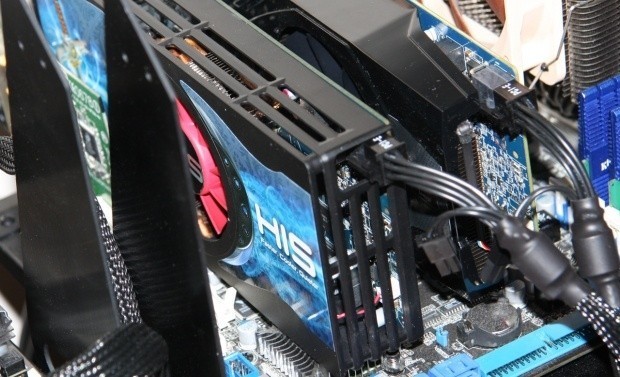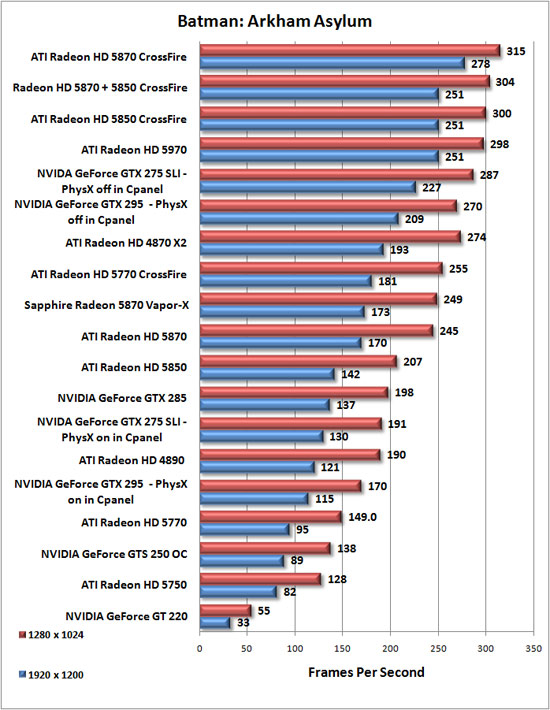

That's the only way to make such a powerful solution with almost 2 billion transistors and keep the cost of ready graphics card at about $200. Like its top-class predecessor, the new mid-end GPU GF104 is also made according to the 40nm process technology.
 Consumes up to 150/160 W via two 6-pin connectors. 2 x Dual Link DVI-I, 1 x HDMI mini, resolutions up to 2560x1600. 37.8 Gtexel/s theoretical texture fetch. 16.2/21.6 Gpixel/s theoretical peak fillrate. 3600 (900x4) MHz effective memory clock rate.
Consumes up to 150/160 W via two 6-pin connectors. 2 x Dual Link DVI-I, 1 x HDMI mini, resolutions up to 2560x1600. 37.8 Gtexel/s theoretical texture fetch. 16.2/21.6 Gpixel/s theoretical peak fillrate. 3600 (900x4) MHz effective memory clock rate. 
1350 MHz universal processors clock rate.GeForce GTX 460 reference card specifications Integrated support for RAMDAC, 2 x Dual Link DVI, HDMI, DisplayPort.
 Recording results of up to 8 frame buffers simultaneously (MRT). 4 wide ROPs (32 pixels) supporting antialiasing up to 32x, also with FP16, FP32 frame buffers each unit features an array of configurable ALUs and handles Z generation and comparison, MSAA, blending. 64 texture addressing and filtering units supporting FP16, FP32 precision in textures, as well as support for trilinear and anisotropic filtering for all texture formats. 8 Stream Multiprocessors, including 384 scalar ALUs for floating-point computing (support integer, FP, FP32, FP64 according to the IEEE 754-2008 standard). 256-bit memory bus, 4 independent 64-bit controllers, support for GDDR5 memory. Hardware support for the DirectX 11 API, including the Shader Model 5.0, geometry and compute shaders, as well as tessellation. Unified architecture with an array of processors for stream processing of vertices, pixels, etc. You might also want to read articles on NVIDIA's previous architectures and solutions:įor now we'll assume that you're already familiar with all NVIDIA GPU architectures and proceed to the specifications of the GF104 GPU and products based on it. Just make sure you've read the review of the GeForce GTX 470/480 graphics cards. Besides, most information on the Fermi architecture was disclosed as far back as in January. The theoretical part won' be long, because GF104 (and GeForce GTX 460) are quite similar to GF100 (GeForce GTX 470 and GeForce GTX 480), all differences being quantitative. GeForce GTX 460 may become as successful for the newer DirectX 11 API. It costed the same, it was also aimed at upper mid-end and offered excellent DX10 performance at affordable price. NVIDIA believes that GeForce 8800 GT was exactly the same solution in the fall of 2007. While 55% of users have cheaper and less than 15% of users have more expensive graphics cards. According to Steam Hardware Survey stats, 31% of users have graphics cards of the aforementioned price range. At least according to NVIDIA's surveys, a typical user changes the graphics card (or the entire system) once in three years, spending about $200-250. And the solution itself promises to be quite a success. Besides, NVIDIA's GF100/GF104 is a completely new architecture, not a reworked old one.īut even now the release of GeForce GTX 460 is timely enough. One reason is that ATI GPUs were somewhat simpler (in terms of transistors per chip). This can be said about the top-class RV870 as well as later GPUs for mid-end and low-end price ranges. First, ATI and NVIDIA had mobile GPUs made, then ATI made its RV740, and NVIDIA got its GT21x solutions.ĪTI was quicker in making new products based on the 40nm process technology. The long-time mastering of the process technology was launched long ago. The reason for the sluggish roll out of both GF100 and GF104 were the same old problems with making such powerful GPUs according to the TSMC's 40nm process technology. The existing GPUs only supported DirectX 10, while the main rival had already been offering DirectX 11 solutions across all price ranges. But in 2010, the need for a new architecture became obvious. For some time, GeForce GTX 260 was enough for most users. Top-class products are beneficial, but don't sell as good as mid-end products do. Obviously, NVIDIA is very interested in affordable solutions based on the new architecture. Now it's time to review the more affordable GPU and graphics cards that come with it. Finally, NVIDIA announced mid-end solutions based on its latest GeForce GTX 400 architecture that we examined as far back as in the beginning of this year (the most powerful product based on this architecture was rolled out later, in March).
Recording results of up to 8 frame buffers simultaneously (MRT). 4 wide ROPs (32 pixels) supporting antialiasing up to 32x, also with FP16, FP32 frame buffers each unit features an array of configurable ALUs and handles Z generation and comparison, MSAA, blending. 64 texture addressing and filtering units supporting FP16, FP32 precision in textures, as well as support for trilinear and anisotropic filtering for all texture formats. 8 Stream Multiprocessors, including 384 scalar ALUs for floating-point computing (support integer, FP, FP32, FP64 according to the IEEE 754-2008 standard). 256-bit memory bus, 4 independent 64-bit controllers, support for GDDR5 memory. Hardware support for the DirectX 11 API, including the Shader Model 5.0, geometry and compute shaders, as well as tessellation. Unified architecture with an array of processors for stream processing of vertices, pixels, etc. You might also want to read articles on NVIDIA's previous architectures and solutions:įor now we'll assume that you're already familiar with all NVIDIA GPU architectures and proceed to the specifications of the GF104 GPU and products based on it. Just make sure you've read the review of the GeForce GTX 470/480 graphics cards. Besides, most information on the Fermi architecture was disclosed as far back as in January. The theoretical part won' be long, because GF104 (and GeForce GTX 460) are quite similar to GF100 (GeForce GTX 470 and GeForce GTX 480), all differences being quantitative. GeForce GTX 460 may become as successful for the newer DirectX 11 API. It costed the same, it was also aimed at upper mid-end and offered excellent DX10 performance at affordable price. NVIDIA believes that GeForce 8800 GT was exactly the same solution in the fall of 2007. While 55% of users have cheaper and less than 15% of users have more expensive graphics cards. According to Steam Hardware Survey stats, 31% of users have graphics cards of the aforementioned price range. At least according to NVIDIA's surveys, a typical user changes the graphics card (or the entire system) once in three years, spending about $200-250. And the solution itself promises to be quite a success. Besides, NVIDIA's GF100/GF104 is a completely new architecture, not a reworked old one.īut even now the release of GeForce GTX 460 is timely enough. One reason is that ATI GPUs were somewhat simpler (in terms of transistors per chip). This can be said about the top-class RV870 as well as later GPUs for mid-end and low-end price ranges. First, ATI and NVIDIA had mobile GPUs made, then ATI made its RV740, and NVIDIA got its GT21x solutions.ĪTI was quicker in making new products based on the 40nm process technology. The long-time mastering of the process technology was launched long ago. The reason for the sluggish roll out of both GF100 and GF104 were the same old problems with making such powerful GPUs according to the TSMC's 40nm process technology. The existing GPUs only supported DirectX 10, while the main rival had already been offering DirectX 11 solutions across all price ranges. But in 2010, the need for a new architecture became obvious. For some time, GeForce GTX 260 was enough for most users. Top-class products are beneficial, but don't sell as good as mid-end products do. Obviously, NVIDIA is very interested in affordable solutions based on the new architecture. Now it's time to review the more affordable GPU and graphics cards that come with it. Finally, NVIDIA announced mid-end solutions based on its latest GeForce GTX 400 architecture that we examined as far back as in the beginning of this year (the most powerful product based on this architecture was rolled out later, in March).








 0 kommentar(er)
0 kommentar(er)
